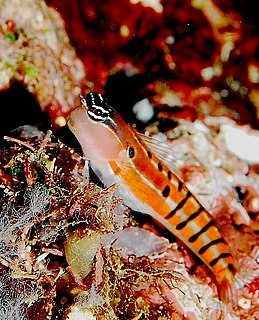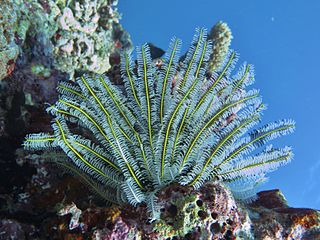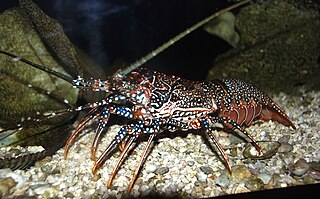
Cnidaria is a phylum under kingdom Animalia containing over 11,000 species of aquatic animals found both in freshwater and marine environments, predominantly the latter.

An echinoderm is any member of the phylum Echinodermata of marine animals. The adults are recognizable by their radial symmetry, and include starfish, brittle stars, sea urchins, sand dollars, and sea cucumbers, as well as the sea lilies or "stone lilies". Adult echinoderms are found on the sea bed at every ocean depth, from the intertidal zone to the abyssal zone. The phylum contains about 7000 living species, making it the second-largest grouping of deuterostomes, after the chordates. Echinoderms are the largest phylum that has no freshwater or terrestrial members.

Marine angelfish are perciform fish of the family Pomacanthidae. They are found on shallow reefs in the tropical Atlantic, Indian, and mostly western Pacific Oceans. The family contains seven genera and about 86 species. They should not be confused with the freshwater angelfish, tropical cichlids of the Amazon Basin.

The orange clownfish also known as percula clownfish and clown anemonefish, is widely known as a popular aquarium fish. Like other clownfishes, it often lives in association with sea anemones. A. percula is associated specifically with Heteractis magnifica and Stichodactyla gigantea, and as larvae use chemical cues released from the anemones to identify and locate the appropriate host species to use them for shelter and protection. This causes preferential selection when finding their anemone host species. Although popular, maintaining this species in captivity is rather complex. The Great Barrier Reef Marine Park Authority regulates the number of collection permits issued to aquarium fish dealers who seek this, and other tropical fish within the Great Barrier Reef Marine Park. The symbiosis between anemonefish and anemones depends on the presence of the fish drawing other fish to the anemone, where they are stung by its venomous tentacles. The anemone helps the fish by giving it protection from predators, which include brittle stars, wrasses, and other damselfish, and the fish helps the anemone by feeding it, increasing oxygenation, and removing waste material from the host. Various hypotheses exist about the fish's ability to live within the anemone without being harmed. One study carried out at Marineland of the Pacific by Dr. Demorest Davenport and Dr. Kenneth Noris in 1958 revealed that the mucus secreted by the anemone fish prevented the anemone from discharging its lethal stinging nematocysts. A second hypothesis is that A. percula has acquired immunity towards the sea anemone's toxins, and a combination of the two has been shown to be the case. The fish feed on algae, zooplankton, worms, and small crustaceans.

Pillar coral is a hard coral found in the western Atlantic Ocean and the Caribbean Sea. It is the only species in the monotypic genus Dendrogyra. It is a digitate coral -that is, it resembles fingers or a cluster of cigars, growing up from the sea floor without any secondary branching. It is large and can grow on both flat and sloping surfaces at depths down to 20 m (65 ft). It is one of the few types of hard coral in which the polyps can commonly be seen feeding during the day.

Diadema antillarum, also known as the lime urchin, black sea urchin, or the long-spined sea urchin, is a species of sea urchin in the family Diadematidae.

Caesionidae, the fusiliers, are a family of marine ray-finned fishes in the order Perciformes. The family includes about 23 species. They are related to the snappers, but adapted for feeding on plankton, rather than on larger prey. They are found at reefs in the Indo-Pacific and in the Red Sea.

Coral reef fish are fish which live amongst or in close relation to coral reefs. Coral reefs form complex ecosystems with tremendous biodiversity. Among the myriad inhabitants, the fish stand out as colourful and interesting to watch. Hundreds of species can exist in a small area of a healthy reef, many of them hidden or well camouflaged. Reef fish have developed many ingenious specialisations adapted to survival on the reefs.

Coastal fish, also called inshore fish or neritic fish, inhabit the sea between the shoreline and the edge of the continental shelf. Since the continental shelf is usually less than 200 metres (660 ft) deep, it follows that pelagic coastal fish are generally epipelagic fish, inhabiting the sunlit epipelagic zone. Coastal fish can be contrasted with oceanic fish or offshore fish, which inhabit the deep seas beyond the continental shelves.

Ecsenius axelrodi, known commonly as the Axelrod's clown blenny or the Axelrod's combtooth blenny, is a species of ray-finned fish in the family Blenniidae, the combtooth blennies. It is found in shallow water on coral reefs in the western central Pacific Ocean. It was first described by Victor Gruschka Springer in 1988 and named in honour of the American ichthyologist Herbert Richard Axelrod.

Choriaster is monotypic genus in the family Oreasteridae containing the single species Choriaster granulatus commonly known as the granulated sea star. Other common names include big-plated sea star and doughboy starfish. This species is harmless to humans.

Callistoctopus ornatus is a tropical species of octopus native to the Indo-Pacific region. Other common names include white-striped octopus and night octopus, in reference to its nocturnal habits. It was previously known as Polypus ornatus. C. ornatus is edible and was recorded in a Hawaiian market in 1914 by S. S. Berry.

Comatulida is an order of crinoids. Members of this order are known as feather stars and mostly do not have a stalk as adults. The oral surface with the mouth is facing upwards and is surrounded by five, often divided rays with feathery pinnules. Comatulids live on the seabed and on reefs in tropical and temperate waters.
Davidaster discoideus or the beaded crinoid is a species of feather star in the family Comatulidae. It was previously known as Nemaster discoidea but the World Register of Marine Species has determined that the valid name is Davidaster discoideus. It is found on reefs in the Caribbean Sea and northern coast of South America.

Comaster schlegelii, the variable bushy feather star, is a crinoid in the family Comatulidae. It was previously classified as Comanthina schlegeli but further research showed that it was better placed in the genus Comaster. It is found on shallow water reefs in the western Pacific Ocean.

Comaster nobilis, the noble/yellow feather star, is a crinoid in the family Comatulidae. It was previously classified as Comanthina nobilis but further research showed that it was better placed in the genus Comaster.
Ophidiaster granifer, the grained seastar, is a species of starfish in the family Ophidiasteridae. It is found in the Red Sea and the Indo-Pacific and is the only known species of starfish to reproduce by parthenogenesis.

Panulirus guttatus, the spotted spiny lobster or Guinea chick lobster, is a species of spiny lobster that lives on shallow rocky reefs in the tropical West Atlantic and Caribbean Sea.

Cladocora caespitosa, commonly known as cushion coral, is a stony coral of the subclass Hexacorallia. This species forms the only true coral reef in the Mediterranean Sea.

Holothuria (Thymiosycia) impatiens, commonly known as the impatient sea cucumber or bottleneck sea cucumber, is a species of sea cucumber in the genus Holothuria, subgenus Thymiosycia.


















